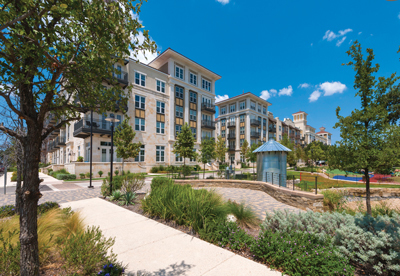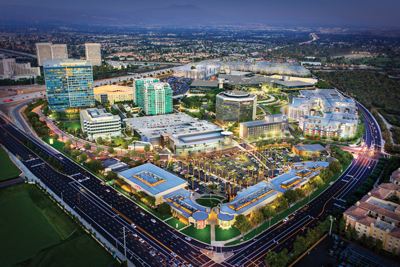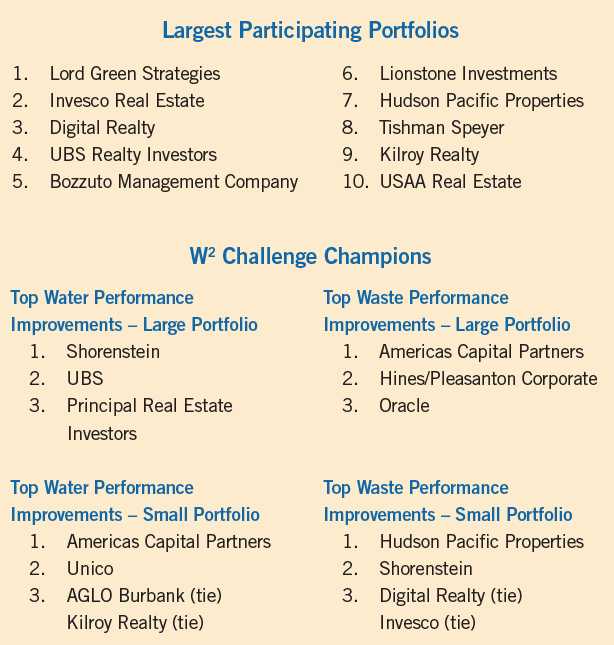BOMA International’s two-year W2 (Water and Waste) Challenge has come to a close, and it’s clear the program resonated deeply with the commercial real estate industry. Originally designed to support real estate practitioners in benchmarking water usage and waste output, sharing best practices and identifying areas for improvement, the program has exceeded all expectations. Nearly 2,000 buildings from more than 400 cities across the United States participated, representing nearly half a billion square feet of space shared with the challenge in the ENERGY STAR® Portfolio Manager®.
W2 Challenge participants committed to enter water and/or waste data at least quarterly in Portfolio Manager throughout 2018 and 2019. In return, they received progress reports and scorecards, and they were supported with educational resources and recognition opportunities. By participating, property professionals were able to better understand their properties’ water and waste usage and compare their performance to that of their peers. Potentially, they also could expand their sustainability efforts, reduce operating costs and earn recognition for their leadership.
DRIVING FORCES
The concept of the challenge originally arose from BOMA International’s Energy and Environment Committee and took form with the support of a generous grant from BOMA Cornerstone Partner Yardi, along with a partnership with ENERGY STAR and the BOMA local associations.
"Yardi has been thrilled to support BOMA and the W2 Challenge," says Akshai Rao, vice president at Yardi. The company supported the challenge from its inception through to its conclusion as part of a broader, ongoing partnership with BOMA International aimed at achieving market transformation through sustainability. "The continued emphasis on sustainability and conservation in the real estate industry is something Yardi values greatly and will continue to support," says Rao.
The driving premise behind the challenge was that the real estate industry is committed to sustainability and has a proven track record of leadership, especially in energy efficiency. Naturally, participation was the key to the program: BOMA membership was not a requirement and properties could be from any building sector.
That premise proved to be a success: The program saw massive participation among nearly all building sectors. Just over half of the participating buildings were office and another quarter were multifamily. Data centers, retail, food service, manufacturing and warehouses, entertainment and medical office buildings also were represented. Participation continued to grow throughout the program, increasing by 40 percent over the course of the campaign.
COMPOUNDING RESULTS
While the emphasis was on participation, there was abundant aggregate and anecdotal evidence showing performance improvements. Industry-wide, the results were sometimes staggering: Among the many sectors represented, one year-over-year analysis reveals that office sector participants reduced their water-use intensity by 68 percent. Retail and food service participants reduced their waste-use intensity by 81 percent.
The W2 Challenge also demonstrated the impact of voluntary benchmarking, including promoting the widespread acceptance of Portfolio Manager as a convenient tool for tracking water and waste, in addition to energy usage, and demonstrating potential cost savings.
The resources produced as part of the challenge will continue to drive progress, particularly the Water Conservation Improvement Guide and Waste Management Improvement Guide, which feature comprehensive checklists of action-oriented recommendations and best practices.
RISING TO THE CHALLENGE
In addition to the W2 Challenge champions (see sidebar below), other success stories from the program demonstrate its scope and impact. Following are three individual property case studies, representing just a sampling of the success stories that arose from the program.
Expanding Sustainability Efforts Beyond Energy

Ballantyne Corporate Park
Charlotte, North Carolina
Managed by: Northwood Office
This massive 535-acre corporate park includes 40 Class A office buildings representing a variety of organizations and tenants. Ballantyne had already achieved a reputation for responsible development, but Northwood viewed the W2 Challenge as an opportunity to expand beyond their energy management success and demonstrate leadership by tracking water and waste.
The team switched from manually estimating the overall tonnage of waste per building to using a new, more efficient waste hauler equipped with individual scales on their trucks. They also are providing daily data for all of their stakeholders and holding recycling seminars for tenants.
As a result of using Portfolio Manager to track both waste and water, the team has identified opportunities for improvement. Seeing the difference in performance among three identical buildings helped them discover where water had been left running. They also prioritized communicating information back to tenants in a number of ways, including a screen in the main lobby of each building that displays the building’s energy, water and waste footprint.
Going forward, the facilities team hopes to start a competition between buildings, and using Ballantyne as an example, Northwood is hoping to expand their water and waste management efforts across their North American portfolio.
Achieving Resilience Through Water Conservation

The Residences at La Cantera
San Antonio, Texas
Managed by: USAA Real Estate
This 425,000-square-foot multifamily building is part of a vibrant mixed-use development that includes retail and office space, co-developed by USAA Real Estate and Cambridge Development Group. With San Antonio often experiencing drought conditions and restrictions on irrigation and water features, the developers sought to create an attractive property that placed an emphasis on resilient design and green construction strategies.
A focus on water conservation included ENERGY STAR-certified dishwashers, high-performance faucets and show-erheads and positioning water heaters close to where the fixtures were located. The team implemented a comprehensive storm water management system that directed runoff efficiently, and they installed another system that collects water from air-conditioning condensate.
Water that would typically be runoff is now treated, stored in a 10,000-gallon cistern and used for irrigation and water features. Combined with a landscaping plan that features native and drought-tolerant plants, the property can meet all of its irrigation needs from its collection system.
Improving Waste Diversion Rates

Park Place Corporate Campus
Irvine, California
Managed by: LBA Realty
This 1.8 million-square-foot corporate campus relies on sustainability initiatives to attract desirable tenants, reduce operating expenses and minimize its carbon footprint.
LBA Realty instituted two programs that dramatically raised the waste-diversion rate from 18 percent to 46 percent. First, a recycling incentive program provided monthly gift cards to janitorial crews who ensured cardboard and paper were disposed of properly in recycling receptacles, while the waste hauler helped offset the cost by incentivizing the property to increase diversion through a rebate.
W2 CHALLENGE CHAMPIONS
Hats off to the top performers of the W2 Challenge! These portfolios were especially successful at benchmarking water and waste. BOMA International and its partners thank the thousands of properties and participants who made this program a resounding success.

Second, the property team partnered with its waste consultant to create an organics recycling program and encouraged participation from tenants—especially restaurants. Food waste was recycled into animal feed or composted into a soil amendment.
Using the W2 Challenge as a model, LBA Realty issued an internal challenge to property teams throughout their portfolio to improve water and waste performance, which included communicating best practices and tools through an internal sustainability blog and setting up a recognition program to honor top-performing property teams.
THE NEXT FRONTIER
There is still work to be done in continuing to reduce water usage and waste output across the built environment, and BOMA International will continue to mine the results of the challenge to identify trends and issues across the industry and formulate potential policy recommendations. Even though the W2 Challenge has ended, its benefits live on.